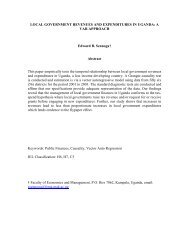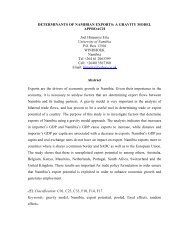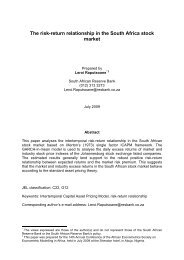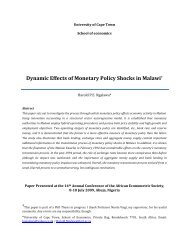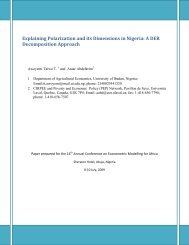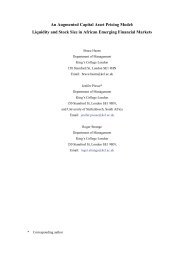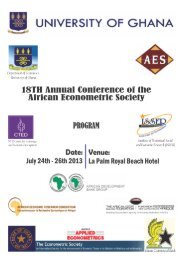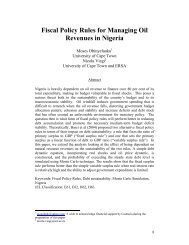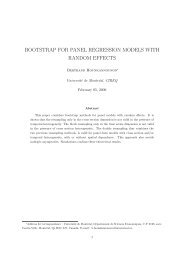The Foreign Exchange Rates in Nigeria - African Econometric Society
The Foreign Exchange Rates in Nigeria - African Econometric Society
The Foreign Exchange Rates in Nigeria - African Econometric Society
Create successful ePaper yourself
Turn your PDF publications into a flip-book with our unique Google optimized e-Paper software.
Auwal and Hamzatco<strong>in</strong>ed the term purchas<strong>in</strong>g power parity to describe such situation. <strong>The</strong> assumption underly<strong>in</strong>gthis approach is that free movement of merchandise would br<strong>in</strong>g about parity between thepurchas<strong>in</strong>g powers of the moneys of different countries, as <strong>in</strong>dicated by national price levels.<strong>The</strong> challenge aga<strong>in</strong>st this approach is how to decide on the choice of the price to be used tocompare ratios of currencies (Isard, 2007). A classic example of this is Churchill's overvaluationof the British pounds <strong>in</strong> 1925(by 12%) after the first world when he used wholesales price toestablish PPP <strong>in</strong>stead of retail price suggested by Keynes.Scholars have modified the PPP approach to take Balassa-Samuelson’s conjecture <strong>in</strong>toconsideration. <strong>The</strong> conjecture po<strong>in</strong>t to the fact that prices of nontradeable tend to <strong>in</strong>creaserelative to the prices of tradable with the growth of an economy. This is borne out of the believethat fast grow<strong>in</strong>g economies experience <strong>in</strong>creased productivity <strong>in</strong> tradable relative tonontradebles.<strong>The</strong> weak l<strong>in</strong>k, however, <strong>in</strong> the Balassa-Samuelson hypothesis, as applied to real exchange rates,is the assumption that the relative prices of tradable-goods across countries rema<strong>in</strong> relativelyconstant over time.<strong>The</strong> third major approach towards determ<strong>in</strong><strong>in</strong>g the equilibrium exchange rate is theMacroeconomic Balance (MB) framework approach. This approach sought an exchange rate thatguarantees <strong>in</strong>ternal and external balance of an economy. In apply<strong>in</strong>g the MB framework, it isuseful to def<strong>in</strong>e the concept of the underly<strong>in</strong>g current account position (UCUR) as the value ofcurrent account position (CUR)that would be observed at the prevail<strong>in</strong>g real exchange rate if allcountries were operat<strong>in</strong>g at full employment or potential output (<strong>in</strong>ternal balance) and if theeffects of past exchange rate changes had been completely realized. This is the appropriateconcept of the medium-run current account position associated with the prevail<strong>in</strong>g real exchangerate. A concept that adjusts for the bus<strong>in</strong>ess cycle(Isard, 2007)Recent advances <strong>in</strong> MB approach l<strong>in</strong>ks current account balance of an economy to the sav<strong>in</strong>g<strong>in</strong>vestmentgap to arrive at equilibrium exchange rate.4



